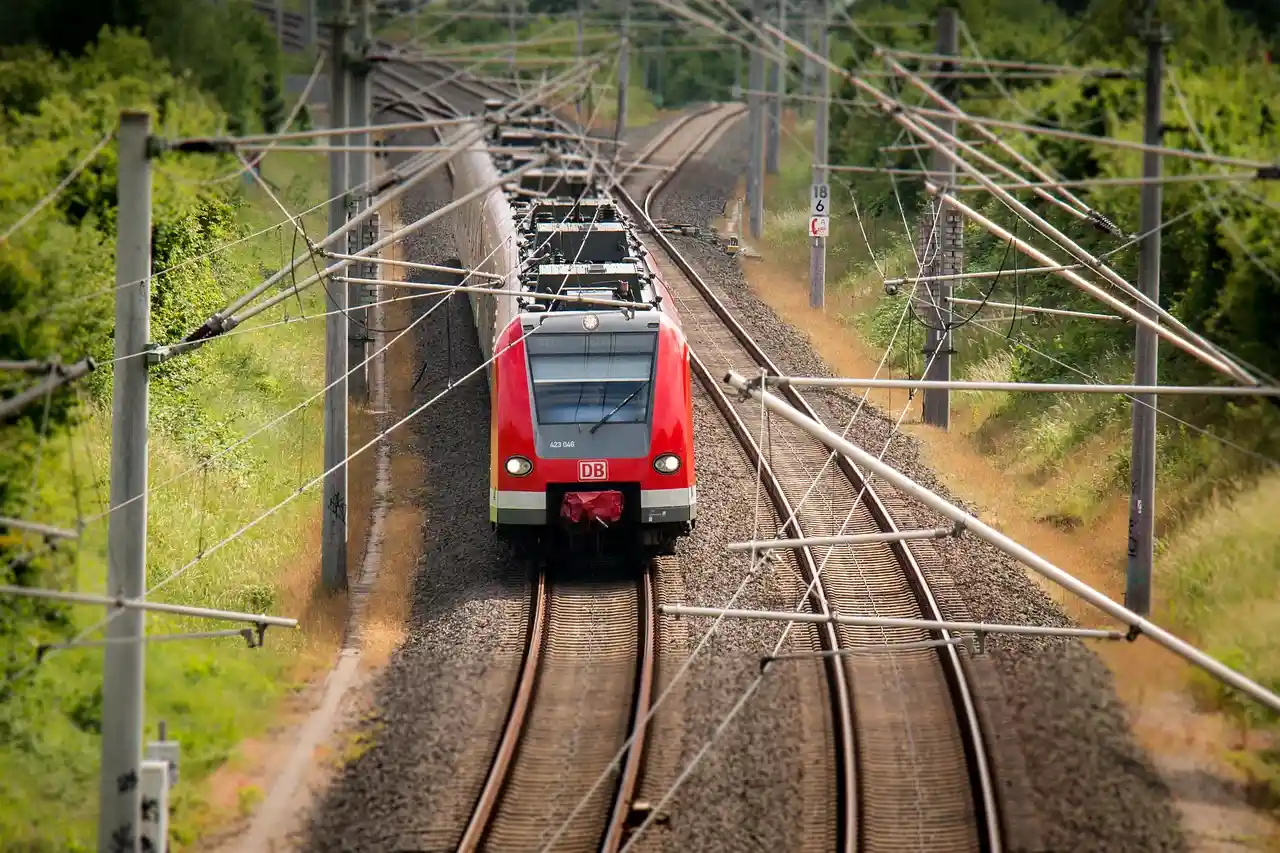Cracking the Code: Europe's Train Travel Enigma - Which Country Leads the Pack?
Europe's Train Travel Secret Revealed! Our latest investigation delves into the mysterious world of European rail journeys to uncover the leading nation in this locomotive adventure. Stay tuned to unveil Europe's leading train travel country!

Unlocking Energy Efficiency: The Power of Public Transport in Reducing Consumption
Boosting the utilization of public transportation and reducing reliance on cars are crucial strategies for aiding Europe in meeting its ambitious climate and energy conservation objectives. Central to the achievement of these goals is Europe's extensive railway network.
The usage and provision of rail passenger transport services vary significantly throughout Europe. Different metrics indicate that Switzerland, Austria, France, and Sweden boast the highest levels of railway usage.
Which European countries have the most frequent train travelers? Which nations exhibit the highest proportion of train utilization in passenger transportation? Furthermore, which countries possess the densest railway networks?

Read Also
Various measures are employed to gauge the frequency of rail passenger transportation. One such measure is passenger-kilometres data, which denotes the average distance traveled on railways (both within the nation and internationally) per person.
Total passenger transport encompasses both national and international passenger travel. The passenger's nationality is not a factor in this calculation. Rather, the focus is on the travel location, as reflected in datasets measuring passenger-kilometres per person and the number of journeys per person.
Concerning international trips, the passenger-kilometres data specifically accounts for the distance covered within national networks during the journey, excluding the distance covered in foreign territories.
Given the significant disparity between travel patterns before and during the COVID-19 pandemic, it's beneficial to analyze figures from both 2019 and 2021. The comparisons made here predominantly rely on data from 2019.
Analyzing Rail Transport: Passenger-Kilometres per Inhabitant for Insightful Data
In the year 2019, Austria stood at the forefront within the European Union in terms of passenger-kilometres, a significant metric illustrating the collective distance traveled by passengers on the railway network, totaling an impressive 1,440 kilometers. Following closely were other European nations, with France securing a strong position at 1,437 kilometers, Sweden at 1,429 kilometers, Germany at 1,208 kilometers, and the UK at 1,078 kilometers. This data showcased the considerable use and reliance on rail transport in these nations, reflecting well-established railway networks and a preference for rail travel.
Moreover, Denmark (1,063 km), Czechia (1,019 km), and Italy (939 km) also surpassed the EU average for passenger-kilometres, indicating the prevalence of rail travel and its efficiency as a mode of transportation in these countries. The figures illustrated the substantial distances covered by passengers on their rail journeys, underlining the integral role of railways in the transportation landscape.
In contrast, Balkan countries generally displayed lower passenger-kilometre numbers per inhabitant. The lower usage of rail transport in these countries could be attributed to several factors, including differing transportation preferences, varying levels of railway development, and alternative modes of travel being more common. Notably, Malta and Cyprus, two island nations, were exceptions within the region, lacking railway systems. The absence of railways in these countries highlights the unique transportation challenges they face due to their geographical nature, which often necessitates a greater reliance on other forms of transportation such as road and maritime travel.
Key Factors Influencing International Travel
In the year 2021, Luxembourg held a prominent position for international rail travel, boasting the most extensive average distance covered by rail travelers, an impressive 136 kilometers per inhabitant. This figure highlighted the efficiency and popularity of rail transport within the country for international travel. Following closely was Switzerland, demonstrating a strong average of 65.2 kilometers per inhabitant, affirming the effectiveness of rail travel in connecting the country to international destinations.
Countries such as Czechia (57.5 km), France (48.6 km), Germany (43.7 km), Denmark (36.8 km), and Austria (26 km) showcased significantly higher averages of passenger-kilometres per inhabitant in international journeys when compared to the overall EU average of 22.7 km. This emphasizes the robust rail infrastructure and the willingness of the population in these countries to opt for rail as a means of international travel, promoting sustainable transportation options.
However, it's important to note that some countries like Estonia, Latvia, Lithuania, and Greece did not report any data on international rail journeys for the year 2021. This lack of data might be attributed to various factors, including reporting mechanisms, rail network development, or data availability, underlining the need for comprehensive and consistent reporting across all European countries for accurate insights into international rail travel patterns.
Train Journeys per Inhabitant: Exploring Rail Travel Patterns in Europe
In the year 2019, Switzerland emerged as the frontrunner in terms of the number of train journeys per inhabitant, boasting an impressive 60.8 travels. This highlighted a robust culture of train travel and a well-utilized railway system within the country. Conversely, Lithuania reported a lower figure of 1.8 journeys per inhabitant, showcasing variations in train travel patterns across different European nations. Luxembourg followed Switzerland closely, recording 40.8 journeys per inhabitant, underlining its efficient and popular rail transport network.
Comparatively, the EU average for train journeys per inhabitant during 2019 stood at 18.4 trips, providing a benchmark against which individual countries' rail travel patterns could be evaluated.
However, as observed, these numbers experienced a significant decline in 2021, likely influenced by the global pandemic and its subsequent impact on travel behavior and restrictions.
In the year 2019, several countries surpassed the EU average for train journeys per inhabitant, showcasing a higher inclination towards rail travel. Denmark stood out with 35.6 journeys per inhabitant, followed by Germany (35.4), Austria (31.4), the UK (27.6), Sweden (25.9), and France (18.8). These figures underscored the importance of rail as a preferred mode of transportation in these nations, emphasizing efficient railway systems and a populace appreciative of the benefits offered by train travel in terms of sustainability and convenience.
The Role of Trains in Passenger Transport: Exploring the Share and Impact
The modal split of inland passenger transport stands as a vital metric that unveils the proportional distribution of various transportation modes, encompassing road and rail, within the overall transport network. It offers insights into the preferences and utilization of each mode and is crucial for understanding the dynamics of the transportation system.
Eurostat, the statistical office of the European Union, defines inland transport as comprising all transport activities conducted over land, excluding air and maritime transport. This encompasses passenger travel by i) private cars, ii) trains, and iii) coaches, buses, and trolley-buses.
The shares for each mode are derived from the total passenger-kilometres, calculated based on the territoriality principle, which considers all transport undertaken within a country's territory.
In 2019, trains constituted 8 per cent of inland passenger transport across the EU, a figure that slightly decreased to 6 per cent in 2021. These statistics demonstrate a notable shift in the share of trains within the overall passenger transport landscape, likely influenced by various factors including societal changes and external events such as the COVID-19 pandemic.
Analyzing 2019 data, the shares of trains in inland passenger transport ranged from 1 per cent in Greece to 13.9 per cent in the EU. Within this spectrum, North Macedonia exhibited the lowest share at 0.6 per cent, while Switzerland led with the highest share at 20 per cent, showcasing a pronounced reliance on trains for passenger transport.
Switzerland's exemplary usage of trains was followed closely by Austria (20 per cent), Sweden (12.2 per cent), the Netherlands (11.2 per cent), and France (10.3 per cent) in 2019. Germany (9.3 per cent) and the UK (8.5 per cent) also surpassed the EU average, demonstrating a substantial share of trains in their respective inland passenger transport.
On the other hand, Balkan countries such as Serbia (0.8 per cent), Greece (1 per cent), and Bulgaria (2.2 per cent) reported very low shares of trains in their inland passenger transport, suggesting a lower preference for rail travel within these regions during that year. Understanding these modal splits provides essential insights into the patterns of transportation usage, aiding in the development of policies to enhance sustainable and efficient transport systems.
Analyzing the Density of Railway Lines: A Key Factor in Transportation Infrastructure
In the year 2021, the density of railway lines, a crucial metric measured in kilometers per 1,000 km² of land area, exhibited significant variations across European countries. Albania reported the lowest railway line density, standing at 8 km, while Switzerland led with an impressive 133 km of railway lines.
Within the European Union, Greece showcased the lowest density at 18 km, while Czechia reported the highest density at 123 km of railway lines per 1,000 km² of land area.
It's important to note that the data encompassed both high-speed and conventional rail lines, encompassing the comprehensive rail network of each country. However, this data excluded light rail networks, metro systems, and trams.
Notably, several countries boasted a railway network density surpassing 100 km. Belgium, based on 2010 data, reported a density of 118 km, while Germany showcased a density of 109 km, and Luxembourg had a density higher than 100 km as well.
In the case of major European nations, the UK demonstrated a railway line density of 67 km, underlining a substantial railway infrastructure. France followed with a density of 43 km, signifying a well-developed and extensive rail network. Spain reported a density of 32 km, emphasizing a moderate density in terms of railway lines across its land area.
Analyzing railway line density provides valuable insights into the infrastructure and transportation capabilities of a country. Higher densities often correlate with efficient and accessible rail networks, contributing to sustainable and convenient passenger and freight transportation. Understanding these densities is essential for effective transportation planning and strategic development of railway systems.
The EU Encourages Minimizing Individual Energy Consumption
The European Commission, with a strong commitment to environmental sustainability and efficient resource utilization, has been actively advocating for a reduction in individual energy consumption. One of the key focal points of this initiative is the recognition of the immense potential that public transport holds in significantly curbing energy consumption on a broad scale.
Public transport emerges as a sustainable alternative that aligns with the European Commission's sustainability goals. It stands out as an energy-efficient mode of transportation, showcasing the capacity to reduce the overall energy demand associated with personal travel. When comparing the amount of energy needed for an individual to travel one kilometer, public transport clearly emerges as a much more energy-frugal choice than utilizing a private car.
In fact, the contrast in energy consumption between public transport and private cars is substantial. Public transport systems, designed to efficiently transport a larger number of passengers, optimize energy consumption per passenger, making them a greener choice. Conversely, private cars tend to consume significantly more energy per kilometer due to factors such as the weight and size of the vehicle, individualized trips, and often less energy-efficient engines.
By urging the populace to opt for public transport, the European Commission aims to not only reduce individual energy usage but also decrease the overall environmental footprint associated with transportation. This strategic shift toward sustainable modes of transport contributes to broader objectives of mitigating climate change, enhancing air quality, and fostering a more eco-friendly future for all. Consequently, fostering a culture of public transport usage becomes a vital element in achieving collective environmental goals while simultaneously promoting a more energy-efficient and sustainable society.






